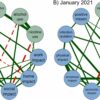Warmer than usual summer nights appear to lead to an increase in cardiovascular deaths in men aged in their early 60s but not women, suggests new research published in the online journal BMJ Open.
Previous studies have focused on the potential for warm spells of weather during the summer that involve extreme or sustained periods of high temperatures to coincide with surges in deaths and hospitalisations due to cardiovascular conditions.
However, findings related to age and gender have been inconsistent so far, so researchers from the University of Toronto, Canada, set out to examine any possible link between summer high temperatures at night and increased cardiovascular disease (CVD) deaths amongst people aged 60 and 69 years.
They studied data from the Office for National Statistics on adult deaths attributed to CVD for the months of June and July in every year between 2001 and 2015 in England and Wales because heatwaves in the UK are most frequent and intense during these months.
They also gathered corresponding information from official U.S. data for King County, Washington, a similarly sea-facing region, at parallel latitude to England and Wales, with comparable land-ocean atmospheric properties and similarly low prevalence of residential air conditioning. The US data, however, only included men.
In addition, they looked at official meteorological data from the UK and the U.S.
Results showed that between 2001 and 2015, there were 39,912 CVD deaths (68.9% men) recorded in England and Wales and 488 deaths in King County.
In England and Wales, after allowing for certain variables, a 1°C rise in the usual summer night-time temperature was associated with a 3.1% increase in the risk of CVD mortality among men aged 60–64, but not older men or either women age groups.
In King County, a 1°C rise was associated with a 4.8% increased risk of CVD mortality among those aged 65 and under, but not in older men.
Over the 15-year time period observed, CVD rates overall declined substantially in both regions annually and notably over the summer months, in line with greater population uptake of effective primary and secondary preventive therapies over time.
Nevertheless, a considerable residual risk persisted, said the authors, and in England and Wales, event rates remained more than 50% higher in adults aged 65–69 than in those aged 60–64 years.
This was worrying, they added, because in recent years, populous regions such as the ones studied had experienced a proportionate rise in night-time rather than daytime summer heat intensity.
This is an observational study, so can’t establish causality, and the researchers acknowledge some limitations to their work such as the unavailability of 15-year sex- and age-specific weekly outcome and exposure data by district or city level, which might have identified stronger associations between night-time summer heat and CVD mortality in populous urban regions.
However, amongst the study’s strengths was its large population size data and use of rigorous national mortality and meteorological data.
They concluded: “The present findings should stimulate similar investigation of exposure and event rates in other populous mid-latitude to high-latitude regions.
“Considering the growing likelihood of extreme summers in Western U.S. and UK, our results invite preventive population health initiatives and novel urban policies aimed at reducing future risk of CVD events.”
More information:
Warmer summer nocturnal surface air temperatures and cardiovascular disease death risk: a population-based study, BMJ Open (2022). DOI: 10.1136/bmjopen-2021-056806
Provided by
British Medical Journal
Citation:
Warmer nights may lead to more cardiovascular deaths among men (2022, March 28)



